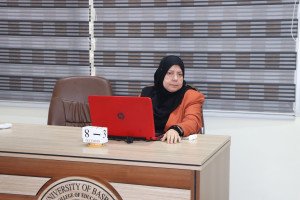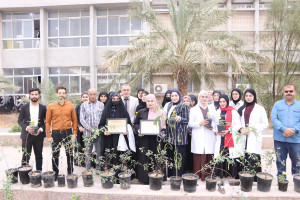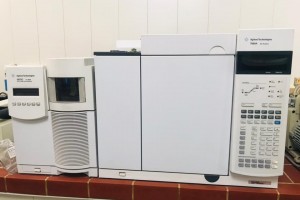
The College of Education for Pure Sciences, Department of Physics, discussed a master's thesis on (A theoretical and practical study of some important physical properties of iodine crystals)
The thesis presented by the researcher (Saad Muhammad Abd) included
The optical absorption spectrum of these samples was studied and we obtained an absorption curve with a high peak at the wavelength of 532nm, where the more we increased the concentration, the more the absorption curve increased, then we calculated the nonlinear optical absorption coefficient and the nonlinear optical refractive index of these samples using the z-scan technique and the values of the highest coefficients at the concentration of 0.05mM
are from measurements of the absorption spectra of iodine solution dissolved in chloroform and for the group of concentrations (0.02, 0.03, 0.04 and 0.05mM) it was found that they have high absorbance (A) within the visible spectrum region, and when the concentration increases, the absorbance increases.
By studying the nonlinear optical properties using the scanning technique in the direction of the third axis - Z and observing the results obtained from the measurements of the nonlinear optical coefficients, it became clear to us that the iodine solution dissolved in chloroform shows the effect of self-defocusing and the reverse saturated absorption process (RSA), which represents that the values of the nonlinear optical coefficients (nonlinear refractive index (n_2) (n_2 <0) and nonlinear absorption coefficient (β)), i.e. they are negative values and they increase with increasing the concentration of the solution. When studying the behavior of the optical determinant of the solution, this study showed that the research sample that was studied has good optical determinant properties, and this is evident by increasing the concentration, as it can be controlled within the range of the laser energy entering the solution. It was also found that there is an inverse relationship between the values of the power threshold (P_th) and the concentration, as the concentration increases, the value of the power threshold for the optical power determinant decreases. When studying the nonlinear optical properties using the self-diffraction technique of the research material. We calculated the nonlinear refractive index (n_2)) based on the number of diffraction rings. The diffraction patterns were clear through the appearance of diffraction rings. At a concentration of (0.02 mM), we obtained a number of rings of 2, so the value of the nonlinear refractive index was (0.11×10^(-6) cm^2/W) for a power of 33 mW. At a power of 40 mW and for the same concentration, the number of rings was 3 with a nonlinear refractive index of (0.13×10^(-6) cm^2/W). At a concentration of (0.03 mM) for a power of 33 mW, the number of rings was 3 and the value of n_2 was equal to (0.17×10^(-6) 〖cm〗^2/W). At a power of 40 mW, the number of rings was 5 and the nonlinear refractive index was (0.23×10^(-6) 〖cm〗^2/W). And so on for the rest of the concentrations, which suggests that the self-diffraction patterns represented by diffraction rings increase. By increasing the capacity and increasing the concentration, this was clear in the shapes of the rings shown in the study. In the last part of the work, we tested the study material in two stages in order to know its effectiveness and use in making optical devices characterized by high efficiency. The first stage was to calculate the value of the performance coefficient for the values of W and T, while the second stage was to calculate the change in the thermal optical coefficient (dn/dT). Through the results obtained in both stages, we found that the study material represented by the iodine solution dissolved in chloroform has high work efficiency for the purpose of using it in optical device applications of various types.









